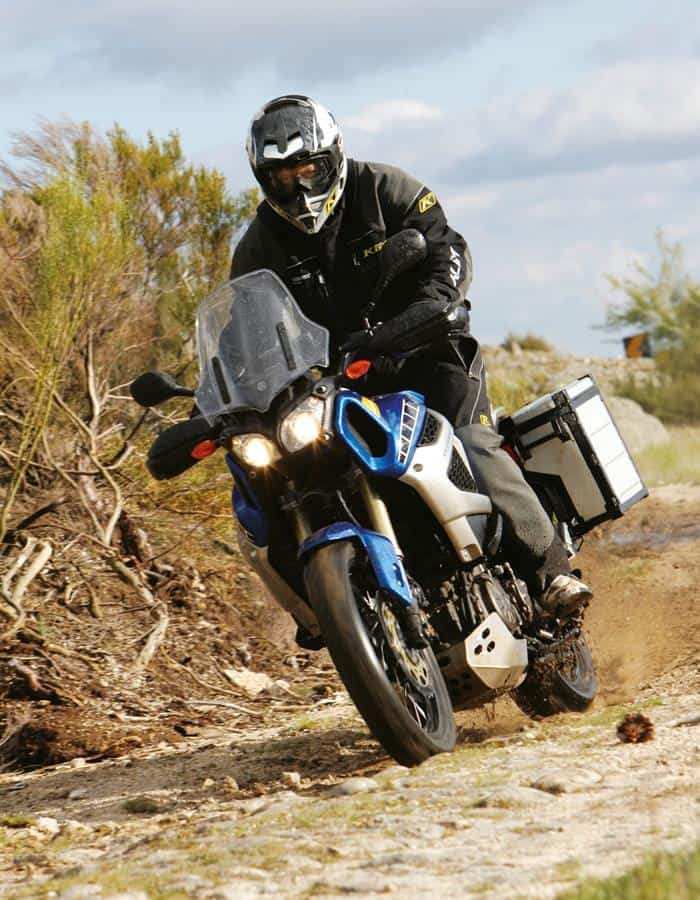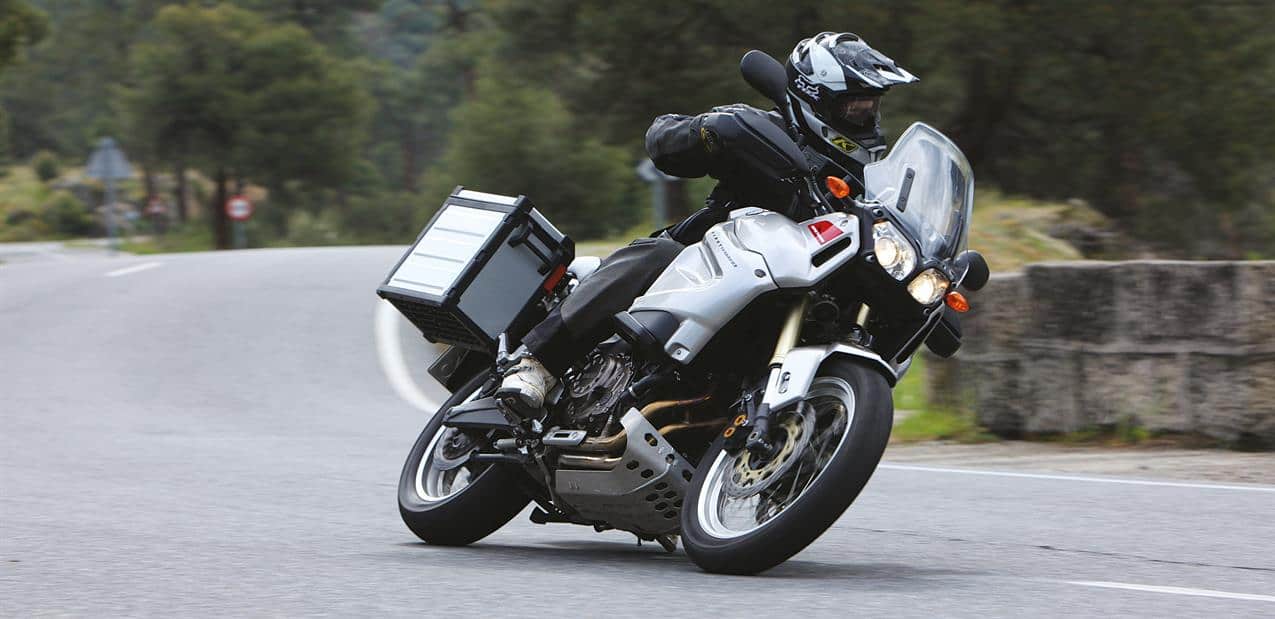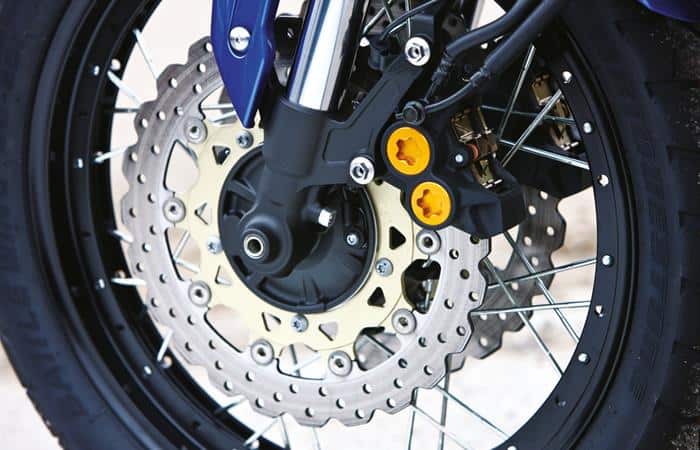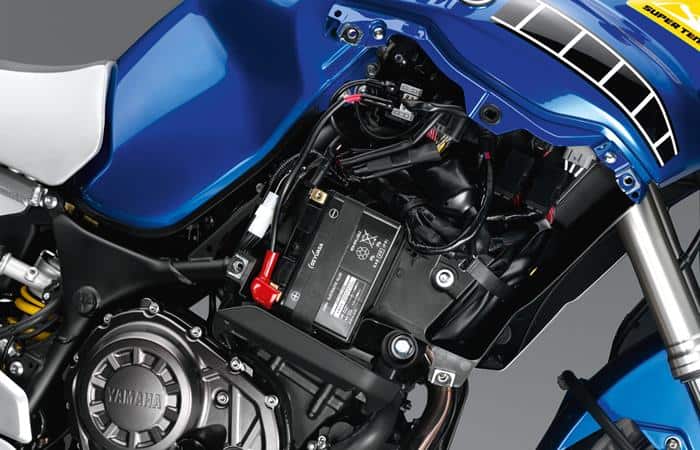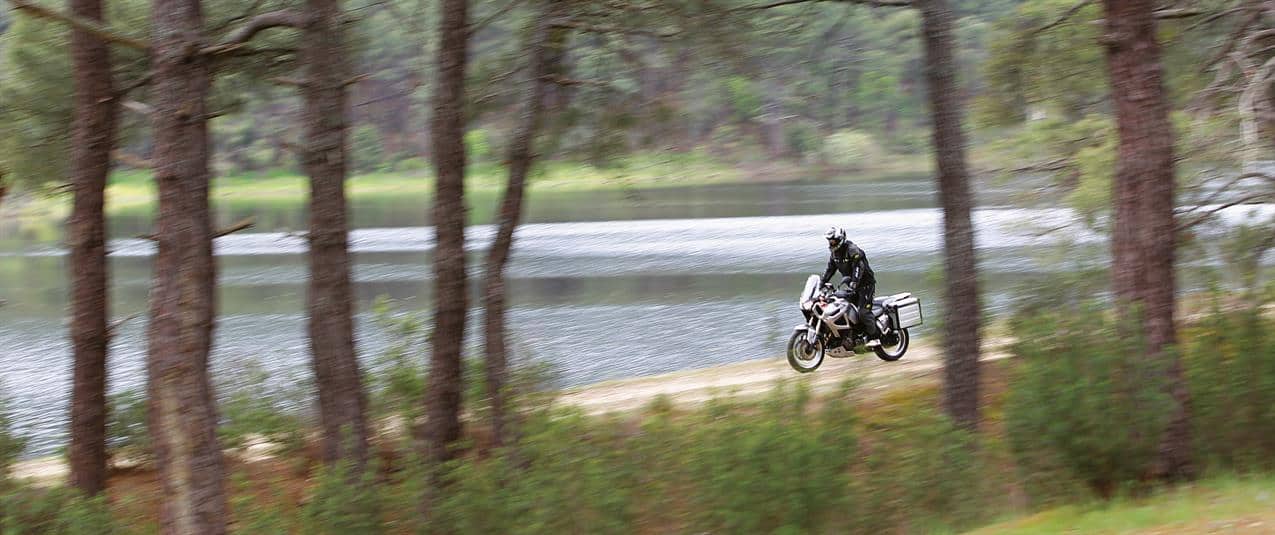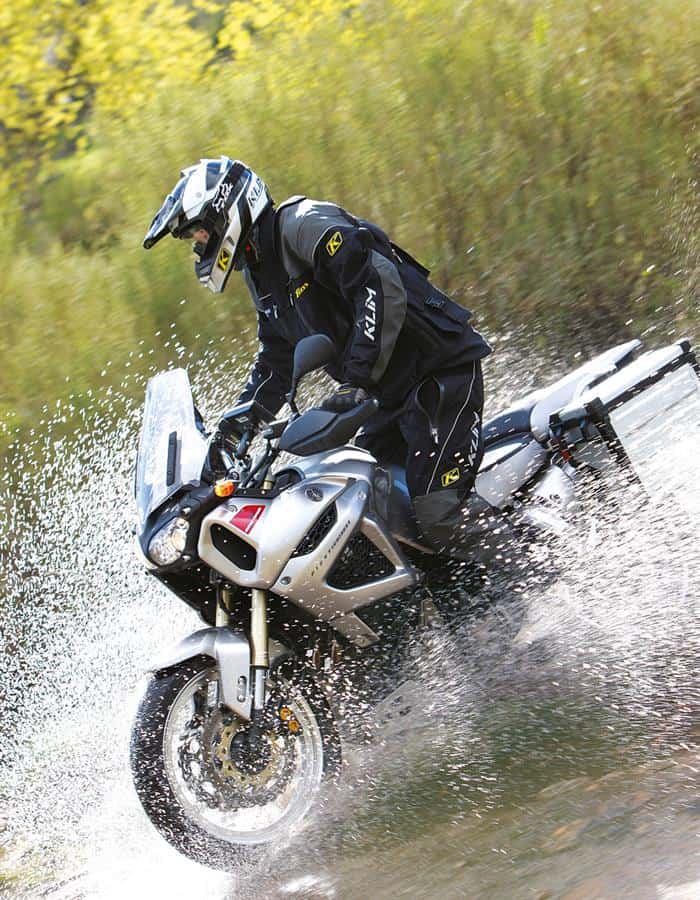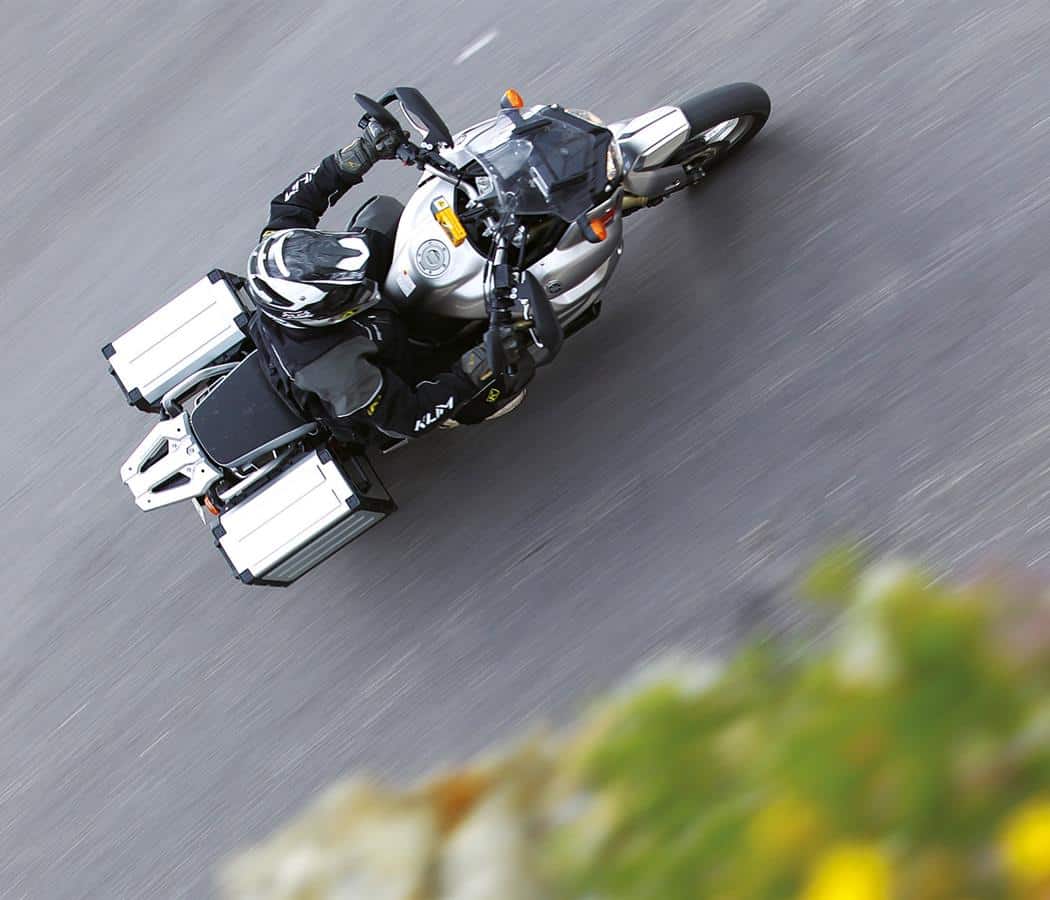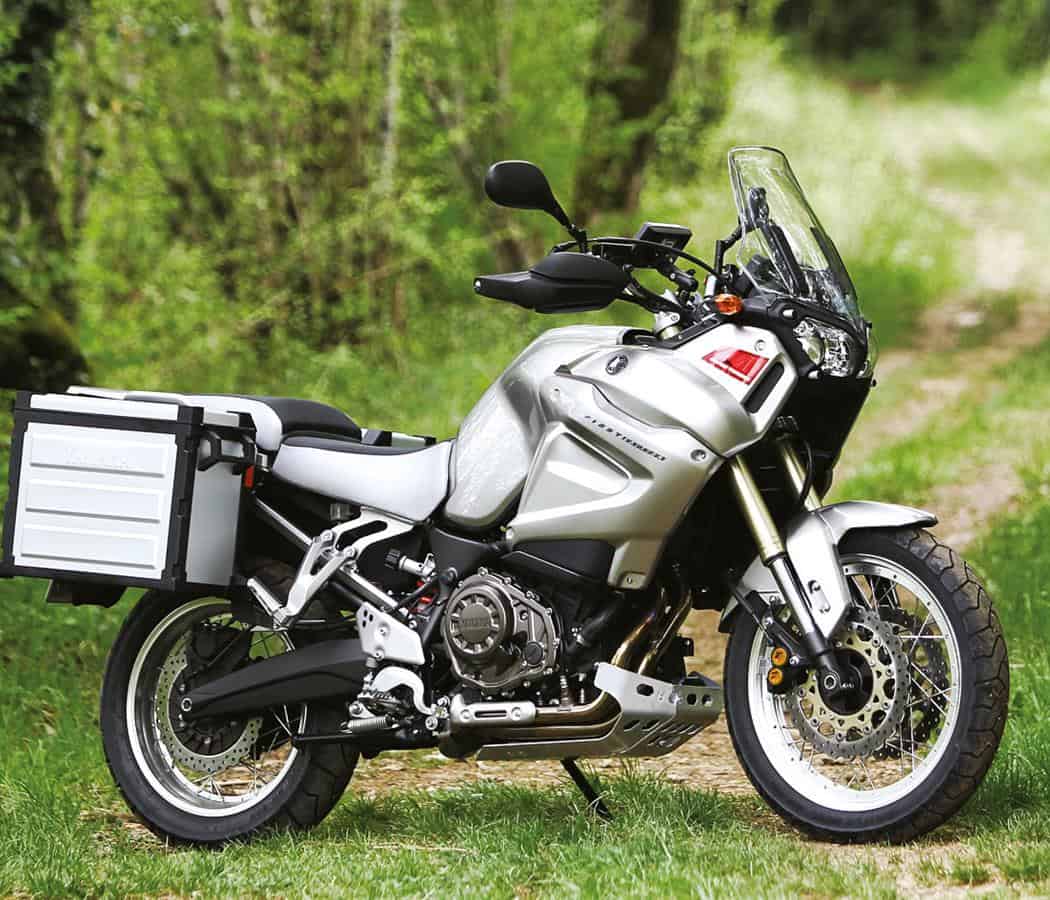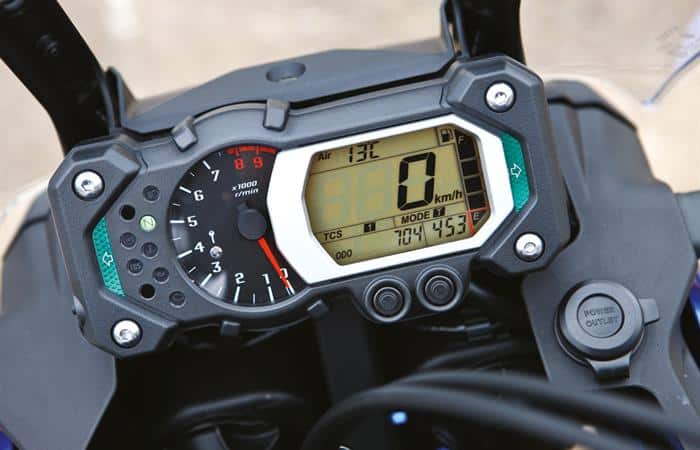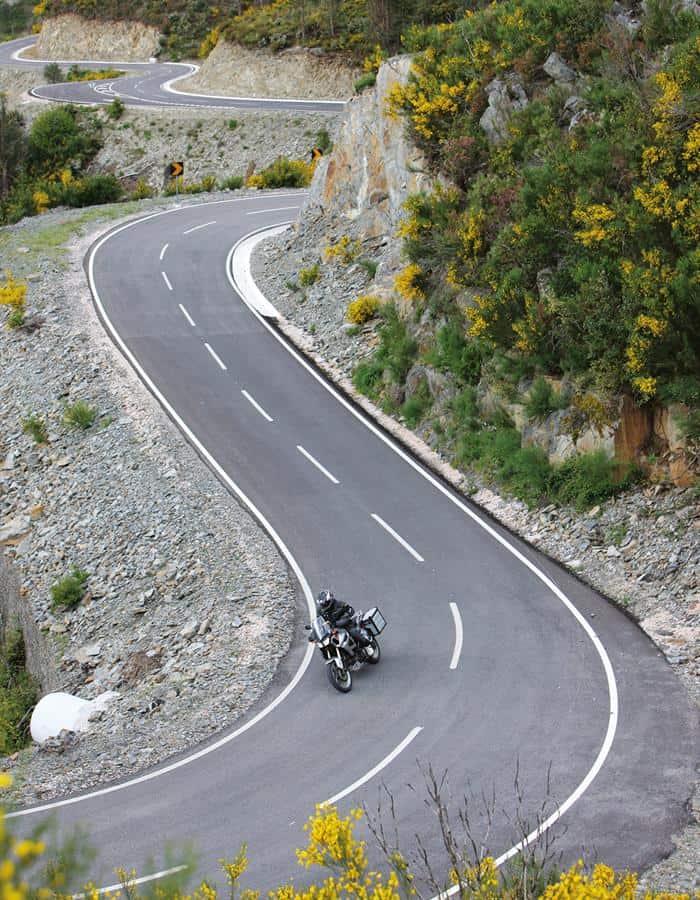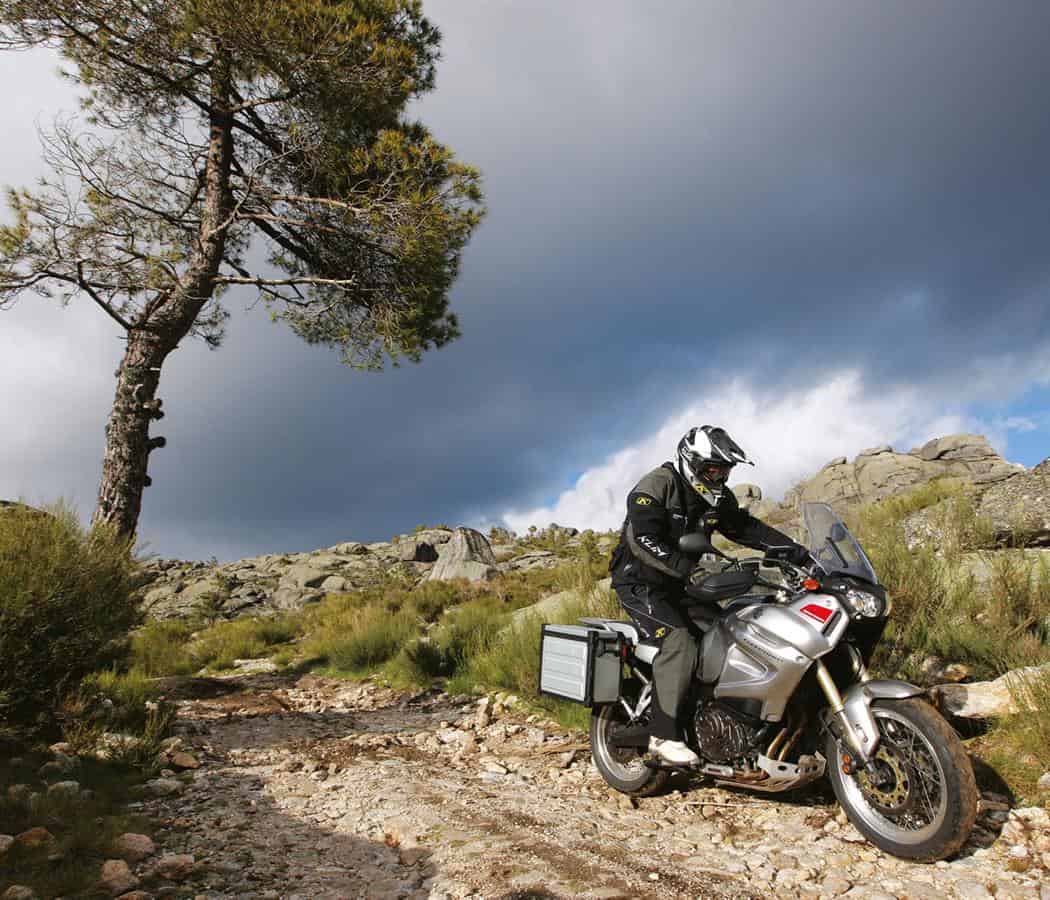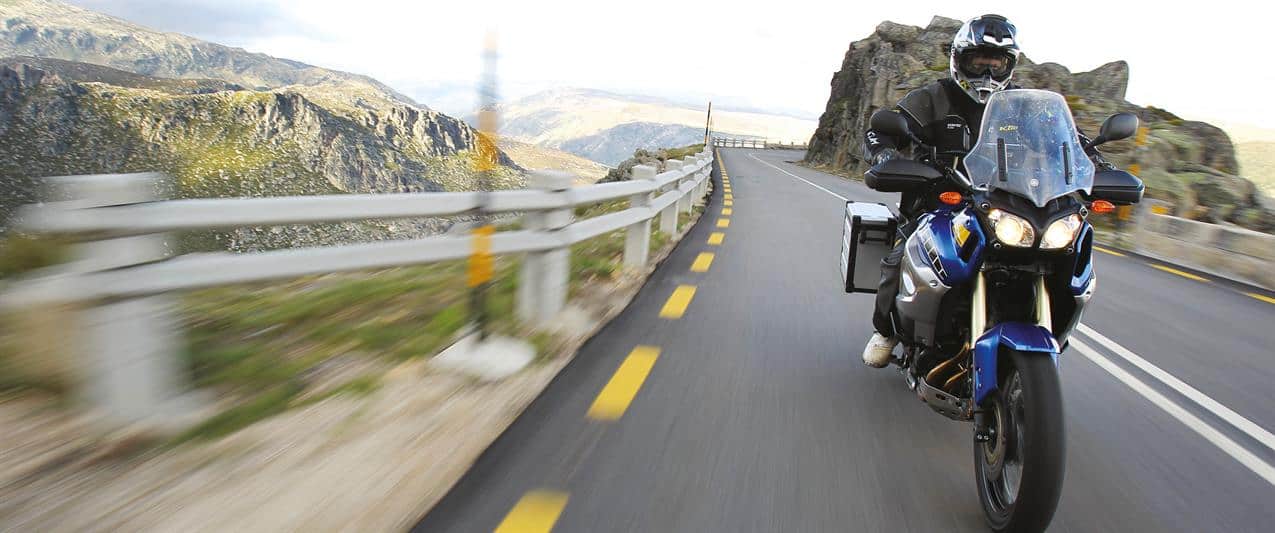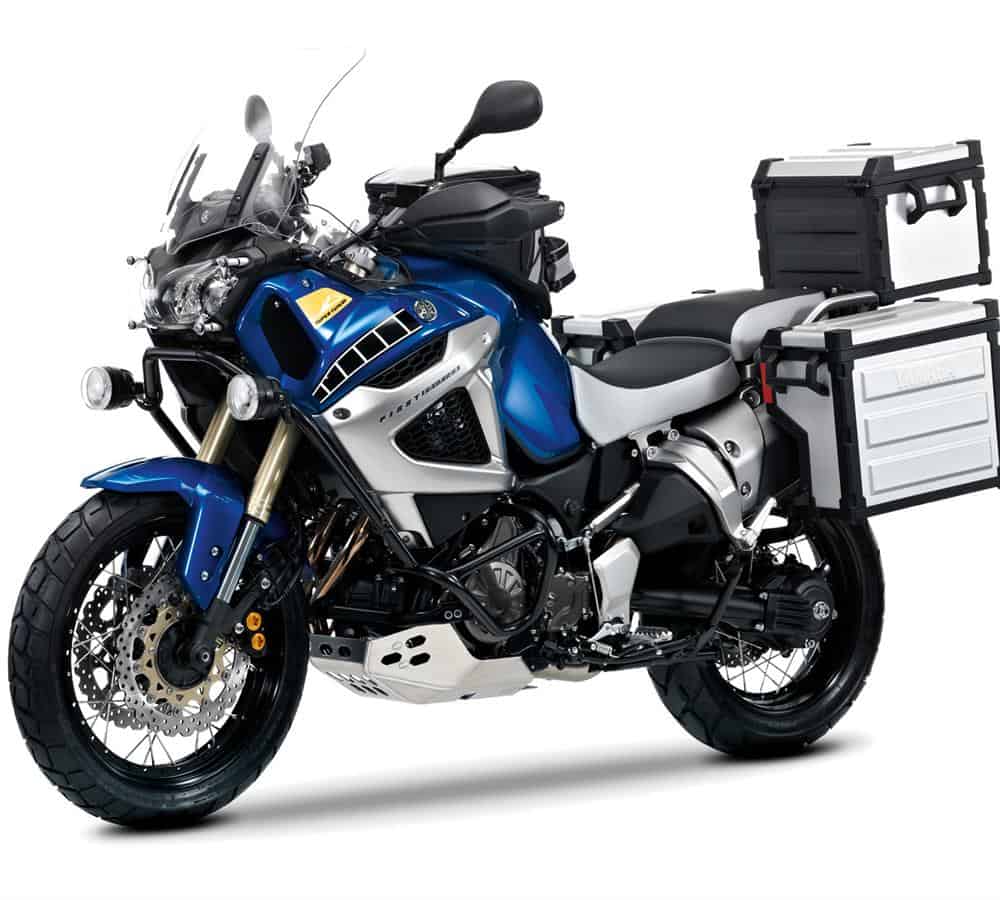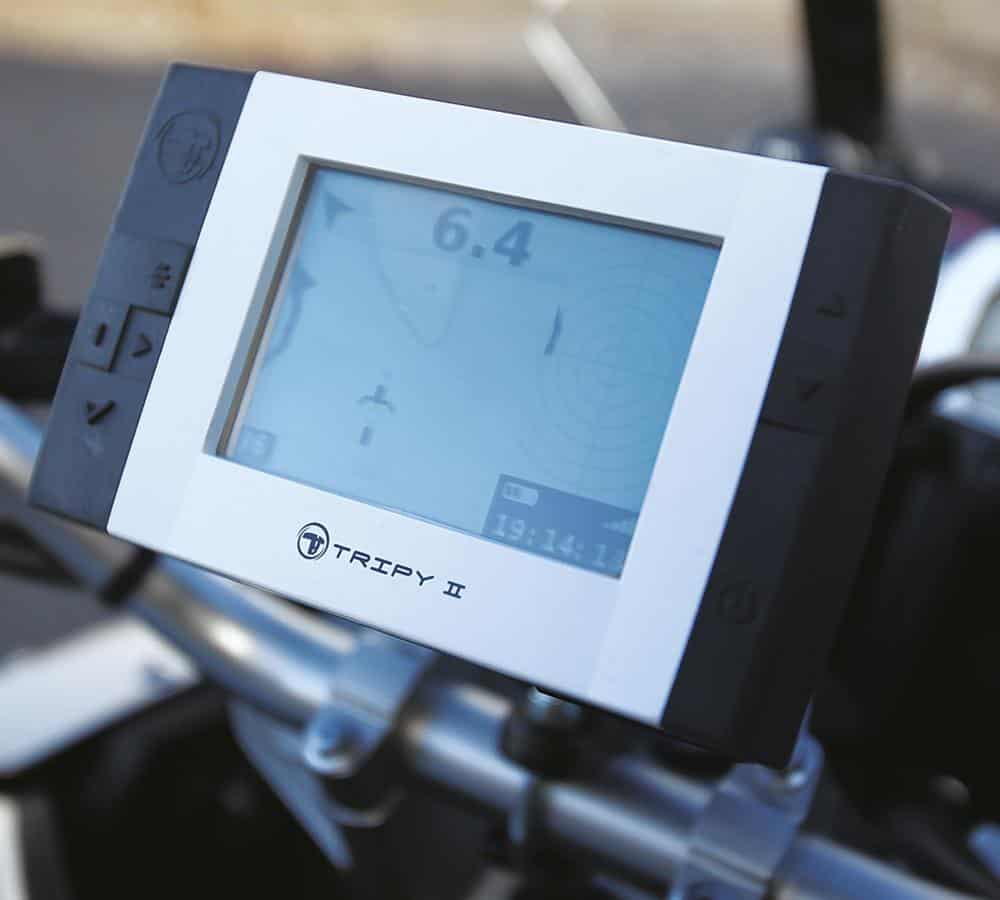Yamaha have finally rejoined the adventure sports market with an all-new 2010 Super Tenere. Is it a rugged big trailie to take on the might of BMW’s 1200GS or simply another soft-roader? After 600 miles through Spain and Portugal we found the answer…
XTZ Super Tenere. The name alone is enough to conjure up a mental image of Stephane Peterhansel blasting across the desolate sands of Mauritania aboard a mighty parallel twin Yamaha desert racer, on his way to giving the model (or at least its YZE850T racing variant) another ‘90s Dakar victory. And, alongside its single cylinder sibling and Honda’s Africa Twin, the 750 is one of those ‘early’ big trailies which has developed a loyal following and enjoys something of a cult status. It’s little wonder therefore, that Yamaha chose to resurrect the model name for its all-new adventure bike.
Rumours that the Super Ten’ name was making a comeback started circulating through the biking world two years ago when Yamaha revived the legendary Tenere name with the XT660Z. After all, a big adventure bike was conspicuous by its absence from their range and the factory could see that they were missing out on a huge sector of the market. (And no, the dated TDM wasn’t gonna cut it!) Then came unofficial artists’ impressions, internet red herrings, and finally confirmation that the bike was on its way… in the shape of a fabric and chrome sculpture at the Tokyo bike show!
A dedicated Super Ten’ website released snippets of info to those wanting more, and then, finally, the XT1200Z Super Tenere was released… And everyone took something of a double take. The styling was pretty, yet lacking something of the 660’s rally bike style, and the specification (with ABS, traction control, two power modes and fly-by-wire throttle) was good, if not exactly groundbreaking. But what really grabbed attention was the fact that at £13,600 the pricetag was just as hefty as the 261kg fuelled-up weight, AND that to get hold of one of the 2010 ‘First Editions’ the only way to buy one is online. Which is a pretty brave move, not just in expecting buyers to place their faith in an untried product but also when you’ve pitched the bike squarely against the undisputed market leader, BMW’s R1200GS, a bike which is both lighter AND cheaper!
Ah yes, the 1200 Gerlande Strasse – the adventure bike against which all others are measured. It’s arguably not the best big trailie on the dirt (that accolade surely rests with the KTM), and in terms of out ‘n’ out performance it gets duffed up by a number of other machines (not least the new Ducati Multistrada), but what it has is fantastic all-round ability and market presence to the point of omnipresence. And it’s those mighty sales figures that the other manufacturers want a piece of.
So the concept behind the Yamaha was, they claim, to build on the old Super Ten’s on-road touring ability whilst including some off-road ability combined with high mileage durability. Shaft-drive and at least one-litre displacement were key criteria and it was to be less off-road oriented than the 660 Tenere and a lot more versatile. Have they managed it? Will the bike steal sales from the German brand? And can you emulate Peterhansel on the new Super Tenere? Well…
Super Structure
Befitting such a bike, Yamaha’s launch was pretty adventurous – riding the bikes from Paris to Marrakech in a four-stage relay, with various members of Europe’s biking press jetting in to pick up the two-wheeled batons at various points along the route. RUST’s leg was the penultimate stretch, riding from Alcala de Henares on the east side of Madrid to Lisbon in Portugal, before the bikes were handed over to the lucky winners of Yamaha’s Ride for Life competition, whereupon they’d head off down to Morocco and then donate five specially painted, up-specced bikes to the Riders For Health charity.
Under the harsh lighting of the hotel’s underground carpark the Super Ten’s sat awaiting scrutiny, the bulging curves of their gleaming bodywork quite at odds with the stark concrete walls and regimented lines of the painted-on parking bays. The blue ‘n’ yellow ‘n’ speedblock colourscheme really stood out… the silver slunk back into the shadows. Anyone who ticks ‘silver tech’ over ‘viper blue’ on the order form is certifiable!
Having togged up, and loaded the panniers (standard on this First Edition, as are the bashplate, headlight guard and FE graphics) we headed out onto the Spanish streets, following our guide rider and, as a back-up, Tripy digital roadbooks (see boxout at the end) for the first day of our 600+ mile ride.
Clogged roads, busy roundabouts and unpredictable driving habits made the first few miles a good test of the ST’s urban credentials. For such a large and, let’s be honest, heavy machine the 1200 felt well balanced and carried its weight well. A surprisingly mellow bottom-end made slow speed manoeuvring remarkably smooth though with the D-Mode adjustable engine mapping set to ‘Touring’ rather than ‘Sport’ it lacked the instantaneous response you’d want for threading a bike through early morning traffic in an unfamiliar town. In fact, once we’d dispensed with the congestion and were out on the open road the ‘Touring’ setting still proved too sedate. Incidentally, it does (eventually) provide the full power of ‘Sport’ setting, just with reduced throttle response. Suffice to say, the bar switch was flicked to ‘Sport’ for the rest of the ride…
A good few kilometres of motorway ring road skirted us around Madrid and provided an initial impression of what the ST would be like at speed. Stable, is the first word that comes to mind as the bike rarely wandered off-line, and the motor was quite happy sitting at 80-90mph.
With the screen on its lowest of the two positions there was a certain amount of wind noise and just a little bit of buffeting to contend with. Ducking down a few inches improved matters considerably, so riders under six foot should find it works well. It’d be another few hours before I could try the screen on its highest setting – making the adjustment is annoyingly more involved than just pressing a button or twirling a couple of knobs.
Although the motor’s 270-degree firing order endows the bike with a muted V-twin-like exhaust note the engine noise itself is a little harsh, reminding me of the company’s WR models. There are some vibes – mainly through the bars and occasionally the pegs – though I can’t say that I ever found them intrusive. The engine’s twin, gear-driven balancer shafts do their job well.
Thankfully, Yamaha haven’t simply slapped a big set of rubber cleats over the pegs, nor fitted hideously narrow or roadbike-spec footpegs. Instead they’ve used a set of wide(ish) dirtbike parts with a hollow rubber insert. The theory behind this is that when you’re simply touring along, sat in the seat, your soles are in contact with the rubber and any vibes are dampened out. When you need get up on the pegs for the dirt your weight compresses the rubber and your boots make contact with the teeth of the pegs. It’s a good compromise and works very well.
Super Star
‘Follow Brunete’ was the suggestion on the Tripy, the digital device clearly having clocked the dark-haired young lady in the car in front. ‘Senorita-spotter’, however, wasn’t one of the nav gear’s features and it was simply leading us down the main road, past the rural town of Brunete and its dusty farmland, and out into more lush surroundings.
As the scenery changed so did the road, becoming sinuous and twisty as it looped around rocky escarpments and along the shoreline of a lake. Stopping at the water’s edge, a small area of hardpacked dirt and humpy rock formation provided an off-road playground. To be quite honest, you could’ve ridden a sportsbike around much of it but it did serve to highlight one key area, that of front-end feel. Other road-biased ‘adventure sports’ machines, such as Suzuki’s V-Strom, lack the kind of feedback from the front that you need to navigate a 200kg+ bike off-road, and it’s good to see that the new Yamaha hasn’t gone the same way. You could always tell when the (tarmac focussed) front tyre was likely to let go and there was little problem in standing up over the tank rally-stylee, leaning forward and letting the back-end hang loose. Now let’s not kid ourselves here, a decent trailie or something like KTM’s V-twin Adventure provides a far greater level of confidence off-road, but the Yamaha’s front-end is nowhere near as vague as it could’ve been.
The rocks provided more of a challenge and had to be negotiated slowly so as to keep the bashplate from clanging down. As with in town, riding around sub walking pace was easy enough, though throw in a few humps, hillocks and cambers and the XT-Z’s weight makes itself very apparent. It’s not a bike you want to stall on an awkward slope! At least the 870mm seat height, or 845mm if you’re running it on it’s low position, means it’s not a problem taking a big dab when the need arises.
From our lakeside stop the roads headed due west, a mix of fast backroads and major routes through the countryside. Hills began to sprout from the horizon and soon we were riding along valley floors and up ‘n’ down their steep sides.
Lunch provided the opportunity to adjust the height of the screen and see if I could lessen the wind noise and that little bit of turbulence I’d been trying to ignore. And so, deep breath, the procedure began…
Off with the seat to liberate a small Allen key secreted in its moulded plastic base. Then remove the right-hand sidepanel via the QD fasteners to reveal the toolkit (and incidentally the battery too). Use the screwdriver to remove the four screws which hold the screen in place, relocate the four rubber grommets in the correct holes and then replace the screen in the new position. Then pack your tools away and remember next time to use the Leatherman you carry in your jacket pocket as it’s far easier, or simply leave the screen in one position…
At least switching the screen to its higher position went some way to alleviating the problem. If you are over six foot though I’d think seriously about fitting the optional tall screen instead.
Super Charged
With full stomachs and, crucially, full tanks after a quick trip to a nearby petrol station, we left our lunch-stop for one of the unnerving roads I’ve ever ridden. Climbing from the bottom of the valley, it zigzagged its singletrack way to the very top and proved to be some of the worst tarmac imaginable. Huge sections of the road looked like they’d suffered a sustained mortar attack, and in-between the potholes sat the debris that’d once filled those voids. Add to that the occasional oncoming truck, blind bends, and the Spanish highways department’s hilarious habit of guardrailing the straights and leaving the corners bare, and it was a road which demanded total concentration.
The Super Tenere’s traction control system (TCS) allowed me to get on with reading the road and not worry too much about its liberal coating of loose gravel on the way out of the turns. The stuttering of the engine as the ignition, throttle and fuel injection all worked in harmony to cut the power accompanied us much of the way up the climb – annoying and intrusive at times, darned handy at others..!
As with the TCS, there were occasions when I was thankful for the standard fitment ABS. Never quite knowing whether the road surface was tarmac’d solidly in place or rolling loose beneath my wheels it too provided one less thing to think about. This was ably demonstrated at the end of one particular straight when my mind was distracted by the full 1km drop to the valley below – a journey that would be unhindered by Armco or any semblance of roadside protection should the unthinkable happen. Suddenly I was immediately and acutely aware of the road turning sharp right and hauled on the brakes across a large section of broken tarmac. With the familiar pulsing of the ABS activating, the Yam slowed predictably on the uneven surface and allowed me to tip into the turn trailing the brakes and avoid an unplanned freefall.
Actually this is a good time to elaborate on the Yamaha’s braking performance. For fast road use the four-piston calipers and twin 310mm wavy discs don’t have a lot of initial bite and I found that one-finger braking scrubbed off some speed but didn’t really haul on the stoppers. With a good two-fingered squeeze the Super Tenere slowed-up quickly, smoothly and with little dive from the 43mm USD front forks thanks to the Intelligent Unified Brake System. By monitoring the bike’s speed, load and how much pressure you apply to the lever it calculates how much rear brake is required and applies it via a hydraulic pump. The system works slightly differently depending upon which lever (front or rear) you go for first and should you only use the rear brake pedal then it’ll only apply the rear brake – handy for slow speed riding. Yamaha personnel were keen to point out how unobtrusive the system is, and I’m happy to report you really don’t notice it at work.
Super Natural
Over the border into Portugal the scenery changed almost immediately. For the roads were lined with orchard-like paddocks rather than the fields of Spain, and amongst the gnarled old trees the floor was a riot of purple and yellow wildflowers. Thankfully, our route remained the same mix of fast corners, slow hairpins and short straights, all rolling across gentle hills on super-smooth asphalt. This is what on-road adventuring’s all about..!
Following a coffee-stop in the small hilltop town of Penamacor, and a run in with the local policia while trying to park 20-odd bikes within its narrow cobbled streets, we carried on towards the mountains of the Parque Natural da Serra da Estrela.
The climb up to the peaks ran along the side of a dramatic glacial valley, with a waterfall cascading down the cliffs on the far side. The road, just wide enough for two cars to squeeze past each other, was a constant flick-flack of corners, with the occasional goat adding an extra chicane or two.
The temperature shown on the Yamaha’s digital dash dropped considerably, even though the sun was still beaming down strong. The clocks are a chunky looking mix of analogue rev counter and digi computer display, showing TCS and D-Mode settings along with two trips (plus a separate low fuel trip), average and instant fuel consumption readings, coolant and (ambient) air intake temperature, fuel level, and odo. Dominating the display is the large speedo readout, whilst bordering the unit are the idiot lights for the indicators. A 12v socket sits on the right-hand-side of the cockpit, handy for sat navs, heated clothing and the like.
Super Tanker
Our day ended at some 1600m above sea level with a spot of off-road riding. Really it was just a few hundred metre there-and-back in front of the photographer’s lens but it showed why the new Super Tenere isn’t really a match off-road for the GS and certainly the KTM Adventure in the rough. And that’s mainly down to its size and weight…
The XT-Z feels big and when things start to go wrong, heavy too. You can scoot through sand with a good dose of throttle, and it’s easy enough to steer with the rear, but should it be deflected by a rut or stone then it takes some judicious, and occasionally flamboyant, body English to get it back on line. (Some higher bars would help when up on the pegs off-road, too.) Now you could perhaps say the same of any bike weighing over 200 kilos, but despite holding much of its weight low in the frame the Super Tenere simply doesn’t inspire the same confidence that you get from the competition.
And it may have similar suspension travel to the standard GS1200 but all that extra weight gives the springs a hard time, even if the forks are more suited to the dirt than BMWs Telelever front-end. Build up some momentum over rough ground or find some holes and rocksteps and you’ll rapidly run out of travel.
Shapely nylon crash bungs on the Super Ten’s flanks look set to provide some reasonable crash protection though whether or not they’ll save the radiator, hidden away behind the left-hand panel, in the event of a big off is a matter of some debate. Yamaha placed the rad there so that they could locate the bike’s weight as far forward as possible, yet retain enough front suspension travel. In doing so they created the problem of vulnerability in a crash and I hope that it proves as tough as they suggest…
Speaking of tough, Yamaha have fitted handguards as standard plus special HD tubeless spoked 19/17in rims to the bike so that the first time you take to the trails you don’t end up with octagonal-shaped rims – part of what they call ‘an extra portion of Tenere toughness’. Cheesy? Yes, but they have at least thought about overland longevity and stated that ‘no part should ever fall off or break through off-road use.’ Bold claims indeed. Overall fit and finish looked pretty good, and over the course of the ride nothing did go missing. That said, the panel gap twixt tank and sidepanels is almost big enough to store your sandwiches in and the tough material on the knees of my riding pants had started to wear away at the paint on the tank…
Super Power
Day two dawned with the mountain-top shrouded in cloud and an early-ish start meant we headed up over the peaks with similarly foggy heads. With the temperature well down into single figures a shower of hail caused additional misery and precluded anything approaching rapid riding. Visibility was down to a couple of hundred yards. Thankfully once we started our descent the weather changed but the roads didn’t – a blazing sun beat down on fantastic mountain passes.
The gearbox wasn’t one of the original Super Tenere’s finest points, though owners could claim that the clunky changes were part of the bike’s character. There’s no need to make excuses for the new ST as shifting gear is a smooth and precise affair. Just as well really, because show the 1200 some twisty tarmac and you’ll find yourself using the gearbox far more than you’d expect.
Much of the Portuguese leg of the ride was spent on delightfully twisting backroads, flicking the bike through all manner of corners and driving hard down short straights. And, as I mentioned to one fellow journo at the end of the day, I never thought I’d have a litre bike held to the stop so frequently. But this isn’t machismo or bar-room boasting, more a sense of disappointment in the new motor! Exit a corner a gear too low and you’re simply left waiting for the DOHC motor to pick up into its mid-range before anything happens. Apparently the old 750cc ST exhibited a similar attribute but it’s not an endearing character trait in a 1200cc tourer!
And even keeping the motor on the boil it never thrilled. The power is smooth and linear from around 4000rpm up to the 7750rpm redline without the kind of rush which makes a 990 Adventure such a buzz to ride. And lacking the lowdown oomph of BMW’s Boxer means the Super Tenere’s engine really works best on fast sweeping roads where you can keep the tacho needle firmly in the midrange.
If the motor disappointed the handling really surprised. I wouldn’t go so far as to describe it as nimble, though for such a large bike it responded well to a nudge on the bars, and tipped into corners assuredly. I’d expected to have to wrestle the ST down the narrow singletrack lanes, yet with the weight low it changed direction particularly well and only on the fastest of flick-flacks did it ever need any real effort to change direction. It was just as well really, because I’d have been utterly frazzled otherwise!
After the singletracks of the mountains came the fast and wide A-roads of the foothills offering a chance to really give the ST its head. An uphill climb, a super-smooth surface, and a crawler lane up the inside made for some wide sweeping lines through a wonderful set of curves at speeds approaching three figures. Up ahead the first couple of riders had just passed a Mercedes taxi and, inexplicably, the driver didn’t respond well to being overtaken. He was immediately hard on the gas, flogging the German motor whilst using all of the road to get the big saloon through the corners as fast as possible.
I sat back to watch and wait, not wanting to get too close to a man possessed, whilst all the time wondering just what his fare thought of his Jekyll and Hyde driving style and whether he’d be picking chunks of vomit out of his beaded seat cover..!
Fortuitously, the first couple of bends had been delightfully constant radius, allowing us to maintain a high corner speed. The third was not. As the front wheels of the Merc scrubbed wide on the tightening corner the car momentarily headed for the oncoming traffic, before the driver regained his senses and backed off. I nipped past – the Yamaha was far, far more composed. Although mid-corner bumps could set off a slight wallow in the plush suspension, on such smooth tarmac the bike was resolutely and reassuringly solid. Fantastic.
The roadside carpark of our lunchstop was awash with adrenaline as riders gabbled about the last few miles and its high-speed corners. A couple of minutes later the Merc rolled up to the lights opposite with a decidedly queasy-looking passenger. Was that diced carrot I could see stuck to the rear view mirror..?
Super Glue
Glistening lines on the road announced the arrival of more rain. Dammit. Except after a tentative few miles our pace began to rise, as everyone became accustomed to the ST’s fabulous wet weather road-holding. ‘Sure-footed’ doesn’t even come close, as there wasn’t the merest hint of a slide from the Bridgestone Battlewings at either end. And here I should really single the rubber out for some praise, as they allowed peg-scraping lean angles in the dry and excellent grip in slick conditions. They’re not much cop on the dirt, but they by no means disgraced themselves so they suit the bike’s intended purpose to a tee.
And dirt was what lay ahead, as we turned off the main road onto a few kilometres of track, wending it’s way through woodland and between farmland. Stopping at the head of the trail, I cut the engine on the killswitch (crucially leaving the ignition on) and flicked through the traction control modes using the button on the side of the dash. TCS1… TCS2… TCS off. Having previously tried the system on the ‘sportier’ of its two settings I’d found that it would let the back-end step out a little but ultimately it was better off-road to turn it off completely.
The throttle response from fly-by-wire system was good and the uneven firing order of the parallel twin meant there was always a healthy amount of feedback from the rear wheel. Balancing traction and slide was never a problem. On a gently undulating hardpack track this allowed the back-end to be flicked through the corners and over the humps at will, even if the occasional rain rut and patch of soft sand served to remind me that this was a big, 260-kilo machine.
Sadly, you can’t switch off the Super Tenere’s ABS and that’s annoying. Okay, so when, at 40mph I leant back, grabbed a big handful of front lever I was amazed to find that the bike slowed to a halt on the dusty dirt with barely a murmur from the ABS system. Yet that doesn’t help when you want to brake turn the back-end around or drift into a corner on the back brake. And what happens on wet grass or on a gravely descent? Well having briefly tried the bike on the latter all I can say is take it steady…
Soon we were back amongst civilisation, Lisbon looming large on the horizon. As we rolled across the Tagus River into the capital it suddenly struck me how comfortable the ST had proved. Neither too soft, nor too hard, the seat foam was just right. Only now, after a second long day in the saddle, was I beginning to experience numb-bum, and the sit-up-and-beg riding position never felt cramped. With 40-or-so mpg giving a 200-mile tank range there’d be no need to perform yoga stretches at every fuel stop.
Super Inflation
I’m sure it’ll be reliable. I’m sure anyone taking it for an adventure will find it a pleasant high mileage tourer. And I’m also sure that it’s no GS beater. Yamaha have set their sights squarely on the BMW and they’ve really just winged it with a bike that needs more power and less weight. Yep, that’s what it boils down to, I’m afraid. For all of its stability and rugged build, it doesn’t really better the competition… and certainly not as a package. I can only really find one quality that I’d hold aloft and shout ‘buy a Super Tenere because of this…’ And that’s the fact that it ISN’T a GS. It isn’t the adventure bike you see everywhere; that TV shows have made instantly recognisable to the man in the street; and that comfortably outsells every other big trailie worldwide.
This may sound harsh, it’s just that I had great expectations of the new Super Tenere, of greater performance, more off-road potential, and some real excitement. So much for those visions of flying across Saharan sands on a new Super Ten’ then! Oh well, you can get pretty much all the way to Dakar by tarmac now, y’know. Best stick to the roads, eh?
Thanks to: Simon Belton at Yamaha UK and all at Yamaha Motor Europe for a memorable launch.
Yamaha XT1200Z Super Tenere
Price: £13,624 OTR
Engine: Twin plug, dry sump, 270º crank, DOHC, parallel twin
Displacement: 1199cc
Bore & stroke: 98 x 79.5cc
Transmission: 6-speed, shaft drive
Frame: Steel tube backbone
Front susp: 43mm USD fork, fully adjustable (190mm travel)
Rear susp: Monoshock, fully adjustable (190mm travel)
Front brake: Twin 310mm discs, four-piston calipers, ABS
Wheelbase: 1540mm
Ground clearance: 205mm
Seat height: 845/870mm
Fuel capacity: 23L
Weight: 261kg (claimed, wet)
Contact: 01932 358000 www.super-tenere.com
Two’s Company
If you’re off on your adventure two-up then you might want to know how your pillion will fair on the back of the Super Tenere, so we took the opportunity to give it a whirl. From the front seat, once you’ve upped the rear preload sufficiently via the handy remote adjuster, the ride is stable and the performance isn’t dulled TOO much by the additional weight – it’ll still pull strongly through the mid-range and cruise above the ton.
Perched on the back, the panniers made clambering aboard a somewhat gymnastic affair and the ally boxes forced my feet forward on the pegs, making my thighs ache after only a few miles. I suspect that this might not be such a problem for a passenger of less gangly build, so small ‘n’ sylphlike pillions may find it okay. The grab-rails were well placed, though the narrow lower edge isn’t particularly ergonomic, and the seat itself was reasonably comfortable.
It’s Tripy, Man!
Using a roadbook is often as simple as following an arrow. You match the terrain to the basic diagram on the ‘book and the prescribed distance, and simply do as it instructs.
Ordinarily, roadbooks are scrolls of paper guiding rally racers along the tracks but Tripy have taken the concept and brought it into the digital age.
Using GPS tracking, once you’ve inputted a route the Tripy will show you they way by pin-pointing your position and telling you how far to go to the next waypoint, where it’ll guide you with a simple directional arrow.
If you get lost you can either flick through to the overview map option or simply find your own way back on target – the Tripy won’t tell you which roads to take, instead it simply displays an arrow pointing in the direction you should be travelling.
Having lived with the system for two days I was impressed at how easy it is to follow, and also its run time. Because it uses basic graphics without fancy colours and displays I’ll run all day without being plugged into a power source.
Check it out at www.tripy.co.uk




